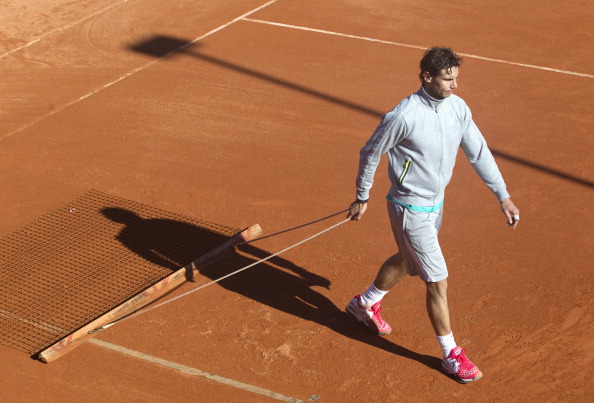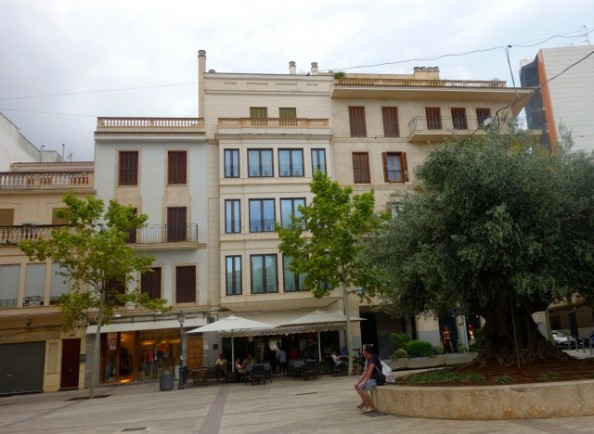
By Michael Mewshaw
After the French Open and Wimbledon, I stay on in Europe and follow the US hard court tournaments on TV. This can be challenging, since in many countries tennis is broadcast exclusively on cable. The Spanish island of Mallorca, home to Rafael Nadal, seemed my best bet to catch the US Open. But when I arrived at my rental apartment, I discovered the TV didn’t carry Sky Sports. Several neighborhood bars did have Sky, but they stayed tuned to soccer around the clock.
I rushed into Palma, Mallorca’s capital, convinced that somewhere some Rafa fan would let me watch his opening match. But I was mistaken. No matter how abjectly I begged, nobody would change the channel to tennis. Locals as well as tourists preferred soccer.
In desperation, I fiddled with the wires on my TV, finally managing to tap into a grainy feed for German Eurosport, where Rafa appeared to be playing Ryan Harrison in a snowstorm. At least I got to see him win, and I picked up a colorful expression. As Harrison gave vent to his frustration, the German commentator called him Mr. Cranky Pants.
That described my mood—Mr. Cranky Pants—when I contemplated the prospect of watching two weeks of tennis through a blizzard of pixels and a barrage of guttural consonants. The next day I traveled to Manacor, figuring that even if I had no luck at picking up a clear picture of the US Open, I’d get a feel for Rafa’s hometown and check out the theory, propounded so often by tennis hacks, that he’s the special child of that specific landscape.
Located on sere flatlands away from lush coastal resorts, Manacor is described by the Time Out Guide as an “ugly, sprawling place” with “a scruffy weekday morning market.” While it’s not as bad as East St. Louis, Jimmy Connor’s hometown, or Compton, California where the Williams sisters dodged drug dealers, Manacor is a gritty conglomeration of rubble-strewn lots and khaki-colored buildings, many of them with bricked-up windows and doors. A billboard on its outskirts refers to it not as Rafa’s home, but as the City of Furniture. Other signs advertised outlets for artificial pearls somehow manufactured out of fish scales.

The Nadal family house stands near the church of Our Lady of Sadness. Its size and its window-filled façade suggest the prominence of its owners. But it’s connected to apartment blocks on either side and and a popular café occupies the ground floor. Rafa no linger lives here. He’s moved to his own villa in the beautiful beach village of Portocristo.
Whereas his muscular depilated image, stripped to the underpants he promotes, graces almost every corner of Paris and London, I didn’t spot a single picture of Rafa in Manacor until I visited the Club de Tenis. With five red clay courts, it’s no more prepossessing than the town, and as I watched middle-age duffers bat balls back and forth, I wondered what role, if any, these places played in Rafa’s triumphant rise.
Ricardo Fernandez, one of the teaching pros, was probably weary of such questions, but he was punctiliously polite and apologized for not shaking my hand. He showed me his palm was crusted with brick dust. He said that Rafa still practiced here for clay court tournaments. For hard court events, he prepared at an indoor facility in Manacor or at the private courts of friends. Since it was difficult to find players of his caliber to hit with, Rafa sometimes imported them from the men’s tour. Ricardo mentioned Argentinian Juan Monaco as one of them.
In the end I asked the question, or rather the related series of questions, that journalists habitually fall back on no matter how often they get useless answers. As a kid growing up in Manacor, what had set Rafa apart? What role did the town and this club play in his development? How important was his family and his groundedness in the community?
“All those things played a part,” Ricardo said. “Sure, it helped to have a family like his that has a sporting tradition.” He spoke of Rafa’s uncle, Miguel Angel, a celebrated soccer player. “And it helped to have a club nearby. But it comes down to chance. Plenty of people have good families and good genes. I see lots of little kids hitting the ball here and it looks like someday they might do something big. But then they go no place and you never hear about them again.”
Ricardo shrugged. “Tennis champions are where you find them. Maybe in Belgium or Serbia or Scotland. When they win everybody wants to know why.” He shrugged again, signaling that in his opinion there was no easy explanation.
I came away from Manacor no longer in a Mr. Cranky Pants mood, at peace with the inexplicable. It didn’t even bother me that I went on watching the US Open through snowflakes. I was determined to enjoy the tournament and to play tennis myself. At a local club I was hitting with my wife when an instructor came onto the next court with a knee-high boy who, although no more than five years old, had an impressive topspin forehand. He had trouble with his footwork, however, and when chasing balls to the corners, he fell several times, skinning his knees. Immediately he scrambled to his feet crying and continued hitting through his tears.
It dawned on me that a bit of bullfighting lore might apply here. To test the bravery of baby bulls, men on horseback ride out and knock them down. Those that get up and charge the horsemen are raised as fighting bulls. Those that give up become hamburger. Maybe that’s the best explanation of Rafa. It’s not just talent or a coach or a hometown that makes a champion. It’s that when he gets knocked down, he gets up and keeps going.
Michael Mewshaw (MikeMewshaw@aol.com) is the author of Short Circuit, which is available as an e-book.


















